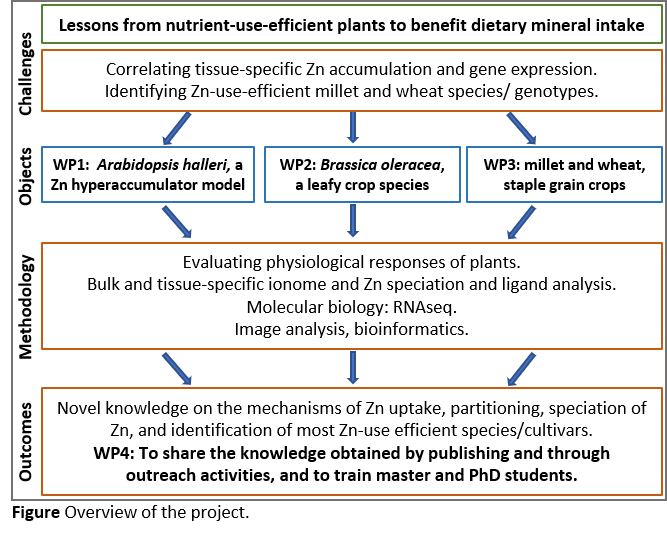Acronym
J4-3091
Contract number
J4-3091
Department:
Department of Biology
Type of project
ARIS projects
Type of project
Basic research project
Role
Lead
Financing
Duration
01.10.2021 - 30.09.2024
Total
1,38 FTE
Project manager at BF
Pongrac PaulaAbstract
Among the important essential elements for humans is zinc (Zn) which is required for nearly all processes within our body. Too little Zn therefore affects many systems negatively. With insufficient Zn, we become more susceptible to infections and are less productive, and prolonged Zn deficiency can cause severe growth defects and impaired brain function. Substantial progress has been made in increasing concentrations of Zn in edible plant tissues and particularly in staple crops. The process is called biofortification. The increase in density of bioavailable essential mineral elements in a crop can be achieved through plant breeding, transgenic techniques, or agronomic practices. To further advance biofortification strategies, in-depth understanding of the network of factors influencing Zn hyperaccumulation (extraordinary ability to accumulate concentrations of Zn considered toxic for majority of plants) and Zn homeostasis in leafy and grain crops is required. We propose to address the grand challenge of correlating quantitative information on the tissue-specific distribution of Zn and intrinsic gene expression network in a Zn hyperaccumulating model plant (Arabidopsis halleri), a leafy crop species (Brassica oleracea) and two staple grain crops, namely millet species (finger, pearl and proso millets) and wheat species differing in ploidity (selected diplod, tetraplod and hexaploids species/subspecies). The proposed project builds on several recent publications and preliminary results of the project team in which: i) variability of Zn concentration in leaves was determined for A. halleri grown in controlled environment and ii) RNAseq of roots and root traits of B. oleracea grown with contrasting Zn and P supply, which revealed candidate genes involved in Zn homeostasis. In addition, drought tolerant crop (different millet species) and wheat species differing in ploidity will be included to explore gene expression link with Zn-use efficiency and tissue specific accumulation and ligands of Zn in the grain. To complement the information on gene network in these species a visualisation technique enabling quantitative element localisation micro-proton induced X-ray emission (micro-PIXE), will be employed to assess tissue-specific Zn accumulation. Micro-PIXE will be complemented with laser ablation inductively coupled plasma mass spectrometry (LA-ICPMS), when larger sensitivity (<1 mg kg-1) and lower resolution (1-20 µm) will be required. Comprising four work packages and twelve tasks the project will engage an interdisciplinary team comprising national and international experts in their respective fields, to deliver knowledge required by plant biologists, agronomists, food technologists, nutritionists, and quality control officials for the development of more nutritious food products. Numerous opportunities to participate in outreach activities within the institutes and universities participating, will enable the interaction with general public, promote the importance of plant nutrition for healthy communities, and the significance to address scientific questions in an interdisciplinary way. The project will enable extensive knowledge exchange by offering open-access to all results and will enable training of master and PhD students and early career scientists to obtain unique set of technical skills in cutting-edge technologies and to develop communication skills (written and oral) and project-management qualities.
Researchers
The phases of the project and their realization
The project will comprise four work packages (Figure):
Work package 1: Lessons from A. halleri, a Zn hyperaccumulating model plant
This work package is a continuation of the collaboration with Prof. Stephan Clemens (Chair of Department of Plant Physiology, University of Bayreuth, Germany; Bayreuth Center for Ecology and Environmental Research, University of Bayreuth, Bayreuth, Germany), a world-recognised expert in metal tolerance in plants who was hosted Dr Pongrac during her Alexander von Humboldt fellowship for postdoctoral researchers (2014-2015). Project teams from the Biotechnical Faculty, Jožef Stefan Institute and National Institute of Chemistry will also contribute significantly by sample preparation, elemental analysis of plant parts and tissues and evaluation of results.
Work package 2: Role of BoZIP3 in tissue-specific Zn localisation in B. oleracea, a leafy crop species
This work package is a continuation of the collaboration with Prof. Philip J. White (James Hutton Institute, Dundee, UK; Full Professor in Biology at King Saud University, Saudi Arabia; Full Professor Huazhong Agricultural University, China; Honorary Professor, The University of Nottingham, UK), a world-renowned expert in plant mineral nutrition who was supervising Dr Pongrac during her Marie Curie IEF (2015-2017), and Dr Sina Fischer (University of Nottingham, UK), an expert molecular biologist working on Whole Genome Duplication in Arabidopsis thaliana. Project teams from the Biotechnical Faculty, Jožef Stefan Institute and National Institute of Chemistry will also contribute significantly by sample preparation, elemental analysis of plant parts and tissues and evaluation of results.
Work package 3: Evaluation of Zn-use efficiency and Zn localisation in selected millet and wheat species
This work package is planned in liaison with Prof. Darja Kocjan-Ačko and Dr Marko Flajšman (both from Department of Agronomy, Biotechnical Faculty, UL), who have been proficiently studying different millet species, and particularly the proso millet genotypes from Slovenia. Wheat species/subspecies have been supplied from International Maize and Wheat Improvement Center (CIMMYT). Project teams from the Biotechnical Faculty, Jožef Stefan Institute and National Institute of Chemistry will also contribute significantly by sample preparation, elemental analysis of plant parts and tissues and evaluation of results.
Work package 4: Dissemination of project development, results and advancements to fellow scientists and the general public
All members on the project will participate in this work package. In addition, PhD students will be encouraged to write publications and attend conferences and knowledge exchange events to discuss the science behind the work, to allow feedback within the wider scientific community and to build their scientific network

